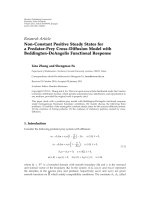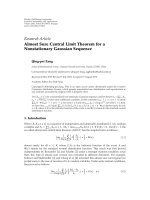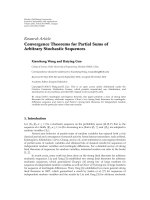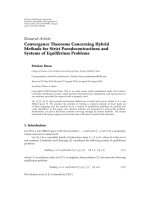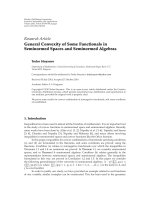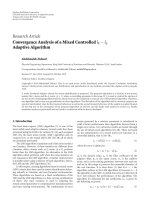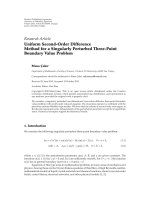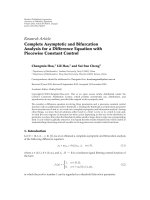Báo cáo hóa học: " Research Article Convergence Theorems of Fixed Points for a Finite Family of Nonexpansive Mappings in Banach Spaces" pot
Bạn đang xem bản rút gọn của tài liệu. Xem và tải ngay bản đầy đủ của tài liệu tại đây (477.11 KB, 7 trang )
Hindawi Publishing Corporation
Fixed Point Theory and Applications
Volume 2008, Article ID 856145, 7 pages
doi:10.1155/2008/856145
Research Article
Convergence Theorems of Fixed Points
for a Finite Family of Nonexpansive Mappings
in Banach Spaces
Yeol Je Cho,
1
Shin Min Kang,
2
and Xiaolong Qin
2
1
Department of Mathematics and RINS, Gyeongsang National University,
Chinju 660-701, South Korea
2
Department of Mathematics Education and RINS, Gyeongsang National University,
Chinju 660-701, South Korea
Correspondence should be addressed to Shin Min Kang,
Received 21 October 2007; Accepted 15 December 2007
Recommended by Jerzy Jezierski
We modify the normal Mann iterative process to have strong convergence for a finite family nonex-
pansive mappings in the framework of Banach spaces without any commutative assumption. Our
results improve the results announced by many others.
Copyright q 2008 Yeol Je Cho et al. This is an open access article distributed under the Creative
Commons Attribution License, which permits unrestricted use, distribution, and reproduction in
any medium, provided the original work is properly cited.
1. Introduction and preliminaries
Throughout this paper, we assume that E is a real Banach space with the normalized duality
mapping J from E into 2
E
∗
give by
Jx
f
∗
∈ E
∗
:
x, f
∗
x
2
, f x
, ∀x ∈ E, 1.1
where E
∗
denotes the dual space of E and ·, · denotes the generalized duality pairing. We
assume that C is a nonempty closed convex subset of E and T : C → C a mapping. A point
x ∈ C is a fixed point of T provided Tx x.DenotebyFT the set of fixed points of T,thatis,
FT{x ∈ C : Tx x}.RecallthatT is nonexpansive if Tx − Ty≤x − y, for all x, y ∈ C.
One classical way to study nonexpansive mappings is to use contractions to approximate
a nonexpansive mapping see 1, 2. More precisely, take t ∈ 0, 1 and define a contraction
T
t
: C → C by
T
t
x tu 1 − tTx, ∀x ∈ C, 1.2
2 Fixed Point Theory and Applications
where u ∈ C is a fixed point. Banach’s contraction mapping principle guarantees that T
t
has a
unique fixed point x
t
in C. It is unclear, in general, what is the behavior of x
t
as t → 0, even if T
has a fixed point. However, in the case of T having a fixed point, Browder 1 proved that if E
is a Hilbert space, then x
t
converges strongly to a fixed point of T that is nearest to u.Reich2
extended Broweder’s result to the setting of Banach spaces and proved that if X is a uniformly
smooth Banach space, then x
t
converges strongly to a fixed point of T and the limit defines the
unique sunny nonexpansive retraction from C onto FT.
Recall that the normal Mann iterative process was introduced by Mann 3 in 1953. The
normal Mann iterative process generates a sequence {x
n
} in the following manner:
x
1
∈ C,
x
n1
1 − α
n
x
n
α
n
Tx
n
, ∀n ≥ 1,
1.3
where the sequence {α
n
}
∞
n0
is in the interval 0,1.IfT is a nonexpansive mapping with a fixed
point and the control sequence {α
n
} is chosen so that
∞
n0
α
n
1 − α
n
∞, then the sequence
{x
n
} generated by normal Mann’s iterative process 1.3 converges weakly to a fixed point
of T this is also valid in a uniformly convex Banach space with the Fr
´
echet differentiable
norm 4. In an infinite-dimensional Hilbert space, the normal Mann iteration algorithm has
only weak convergence, in general, even for nonexpansive mappings. Therefore, many authors
try to modify normal Mann’s iteration process to have strong convergence for nonexpansive
mappings see, e.g., 5–8 and the references therein.
Recently, Kim and Xu 5 introduced the following iteration process:
x
0
x ∈ C,
y
n
β
n
x
n
1 − β
n
Tx
n
,
x
n1
α
n
u
1 − α
n
y
n
, ∀n ≥ 0,
1.4
where T is a nonexpansive mapping of C into itself and u ∈ C is a given point. They proved
that the sequence {x
n
} defined by 1.4 converges strongly to a fixed point of T provided the
control sequences {α
n
} and {β
n
} satisfy appropriate conditions.
Concerning a family of nonexpansive mappings it has been considered by many authors.
The well-known convex feasibility problem reduces to finding a point in the intersection of the
fixed point sets of a family of nonexpansive mappings; see, for example, 9. The problem
of finding an optimal point that minimizes a given cost function over common set of fixed
points of a family of nonexpansive mappings is of wide interdisciplinary interest and practical
importance see, e.g., 10.
In this paper, we consider the mapping W
n
defined by
U
n0
I,
U
n1
γ
n1
T
1
U
n0
1 − γ
n1
I,
U
n2
γ
n2
T
2
U
n1
1 − γ
n2
I,
···
U
n,N−1
γ
n,N−1
T
N−1
U
n,N−2
1 − γ
n,N−1
I,
W
n
U
nN
γ
nN
T
N
U
n,N−1
1 − γ
nN
I,
1.5
Yeol Je Cho et al. 3
where {γ
n1
}, {γ
n2
}, ,{γ
nN
} are sequences in 0, 1. Such a mapping W
n
is called the W-
mapping generated by T
1
,T
2
, ,T
N
and {γ
n1
}, {γ
n2
}, ,{γ
nN
}. Nonexpansivity of each T
i
en-
sures the nonexpansivity of W
n
. Moreover, in 11,itisshownthatFW
n
N
i1
FT
i
.
Motivated by Atsushiba and Takahashi 11,KimandXu5,andShangetal.7,we
study the following iterative algorithm:
x
0
x ∈ C,
y
n
β
n
x
n
1 − β
n
W
n
x
n
,
x
n1
α
n
u
1 − α
n
y
n
, ∀n ≥ 0,
1.6
where W
n
is defined by 1.5 and u ∈ C is given point. We prove, under certain appropri-
ate assumptions on the sequences {α
n
} and {β
n
},that{x
n
} defined by 1.6 converges to a
common fixed point of the finite family nonexpansive mappings without any commutative
assumptions.
In order to prove our main results, we need the following definitions and lemmas.
Recall that if C and D are nonempty subsets of a Banach space E such that C is nonempty
closed convex and D ⊂ C,thenamapQ : C → D is sunny see 12, 13 provided Qx tx −
Qx Qx for all x ∈ C and t ≥ 0 whenever x tx − Qx ∈ C. A sunny nonexpansive
retraction is a sunny retraction, which is also nonexpansive. Sunny nonexpansive retractions
play an important role in our argument. They are characterized as follows 12, 13:ifE is a
smooth Banach space, then Q : C → D is a sunny nonexpansive retraction if and only if there
holds the inequality x − Qx, Jy − Qx≤0 for all
x ∈ C and y ∈ D.
Reich 2 showed that if E is uniformly smooth and D is the fixed point set of a nonex-
pansive mapping from C into itself, then there is a sunny nonexpansive retraction from C onto
D and it can be constructed as follows.
Lemma 1.1. Let E be a uniformly smooth Banach space and let T : C → C be a nonexpansive mapping
with a fixed point. For each fixed u ∈ C and t ∈ 0, 1, the unique fixed point x
t
∈ C of the contraction
C x → tu 1 − tTx converges strongly as t → 0 to a fixed point of T.DefineQ : C → FT
by Qu s − lim
t→0
x
t
.ThenQ is the unique sunny nonexpansive retract from C onto FT,thatis,Q
satisfies the property u − Qu, Jz − Qu≤0, for all u ∈ C and z ∈ FT.
Lemma 1.2 see 14. Let {x
n
} and {y
n
} be bounded sequences in a Banach space X and let β
n
be a
sequence in [0,1] with 0 < lim inf
n→∞
β
n
≤ lim sup
n→∞
β
n
< 1. Suppose x
n1
1 − β
n
y
n
β
n
x
n
for
all integers n ≥ 0 and lim sup
n→∞
y
n1
− y
n
−x
n1
− x
n
≤ 0. Then lim
n→∞
y
n
− x
n
0.
Lemma 1.3. In a Banach space E, there holds the inequality x y
2
≤x
2
2y, jx y for all
x, y ∈ E, where jx y ∈ Jx y.
Lemma 1.4 see 15. Assume that {α
n
} is a sequence of nonnegative real numbers such that α
n1
≤
1 − γ
n
α
n
δ
n
, where γ
n
is a sequence in (0,1) and {δ
n
} is a sequence such that
∞
n1
γ
n
∞ and
lim sup
n→∞
δ
n
/γ
n
≤ 0 or
∞
n1
|δ
n
| < ∞. Then lim
n→∞
α
n
0.
2. Main results
Theorem 2.1. Let C be a closed convex subset of a uniformly smooth and strictly convex Banach
space E.LetT
i
be a nonexpansive mapping from C into itself for i 1, 2, ,N. Assume that
4 Fixed Point Theory and Applications
F
N
i1
FT
i
/
∅. Given a point u ∈ C and given sequences {α
n
}
∞
n0
and {β
n
}
∞
n0
in (0,1), the
following conditions are satisfied:
i
∞
n0
α
n
∞, lim
n→∞
α
n
0,
ii lim
n→∞
|γ
n,i
− γ
n−1,i
| 0 for all i 1, 2, ,N,
iii 0 < lim inf
n→∞
β
n
≤ lim sup
n→∞
β
n
< 1.
Let {x
n
}
∞
n1
be the composite process defined by 1.6.Then{x
n
}
∞
n1
converges strongly to x
∗
∈ F,where
x
∗
Qu and Q : C → F is the unique sunny nonexpansive retraction from C onto F.
Proof. We divide the proof into four parts.
Step 1. First we observe that sequences {x
n
}
∞
n0
and {y
n
}
∞
n0
are bounded.
Indeed, take a point p ∈ F and notice that
y
n
− p≤β
n
x
n
− p 1 − β
n
W
n
x
n
− p≤x
n
− p. 2.1
It follows that
x
n1
− p
α
n
u − p
1 − α
n
y
n
− p
≤ α
n
u − p
1 − α
n
x
n
− p
. 2.2
By simple inductions, we have x
n
−p≤max{x
0
−p, u−p}, which gives that the sequence
{x
n
} is bounded, so is {y
n
}.
Step 2. In this part, we will claim that x
n1
− x
n
→0asn →∞.
Put l
n
x
n1
− β
n
x
n
/1 − β
n
. Now, we compute l
n1
− l
n
, that is,
x
n1
1 − β
n
l
n
β
n
x
n
, ∀n ≥ 0. 2.3
Observing that
l
n1
− l
n
α
n1
u
1 − α
n1
y
n1
− β
n1
x
n1
1 − β
n1
−
α
n
u
1 − α
n
y
n
− β
n
x
n
1 − β
n
α
n1
u − y
n1
1 − β
n1
−
α
n
u − y
n
1 − β
n
W
n1
x
n1
− W
n
x
n
,
2.4
we have
l
n1
− l
n
≤
α
n1
1 − β
n1
u − y
n1
α
n
1 − β
n
y
n
− u
x
n1
− x
n
W
n1
x
n
− W
n
x
n
. 2.5
From the proof of Yao 8,wehave
W
n1
x
n
− W
n
x
n
≤ M
1
N
i1
γ
n1,i
− γ
n,i
, 2.6
where M
1
is an appropriate constant. Substituting 2.6 into 2.5,wehave
l
n1
− l
n
−
x
n1
− x
n
≤
α
n1
1 − β
n1
u − y
n1
α
n
1 − β
n
y
n
− u
M
N
i1
γ
n1,i
− γ
n,i
. 2.7
Observing the conditions i–iii, we get lim sup
n→∞
l
n1
−l
n
−x
n1
−x
n
≤ 0. We can obtain
lim
n→∞
l
n
− x
n
0 easily by Lemma 1.2. Observe that 2.3 yields x
n1
− x
n
1 − β
n
l
n
− x
n
.
Therefore, we have
lim
n→∞
x
n1
− x
n
0. 2.8
Yeol Je Cho et al. 5
Step 3. We will prove lim
n→∞
W
n
x
n
− x
n
0.
Observing that x
n1
− y
n
α
n
u − y
n
and the condition i, we c an easily get
lim
n→∞
y
n
− x
n1
0. 2.9
On the other hand, we have y
n
− x
n
≤x
n
− x
n1
x
n1
− y
n
. Combining 2.8 with 2.9,
we have
lim
n→∞
y
n
− x
n
0. 2.10
Notice that W
n
x
n
−x
n
≤x
n
−y
n
β
n
x
n
−W
n
x
n
. This implies 1−β
n
W
n
x
n
−x
n
≤x
n
−y
n
.
From the condition iii and 2.10,weobtain
lim
n→∞
W
n
x
n
− x
n
0. 2.11
Step 4. Finally, we will show x
n
→ x
∗
as n →∞.
First, we claim that
lim sup
n→∞
u − x
∗
,Jx
n
− x
∗
≤ 0, 2.12
where x
∗
lim
t→0
x
t
with x
t
being the fixed point of the contraction x → tu 1 − tW
n
x. Then
x
t
solves the fixed point equation x
t
tu 1 − tW
n
x
t
. Thus we have
x
t
− x
n
1 − tW
n
x
t
− x
n
tu − x
n
. 2.13
It follows from Lemma 1.3 that
x
t
− x
n
2
1 − t
W
n
x
t
− x
n
t
u − x
n
2
≤ 1 − 2t t
2
x
t
− x
n
2
f
n
t2t
u − x
t
,J
x
t
− x
n
2t
x
t
− x
n
,J
x
t
− x
n
,
2.14
where
f
n
t
2
x
t
− x
n
x
n
− W
n
x
n
x
n
− W
n
x
n
−→ 0, as n −→ 0. 2.15
It follows from 2.14 that
x
t
− u, J
x
t
− x
n
≤
t
2
x
t
− x
n
1
2t
f
n
t. 2.16
Letting n →∞in 2.16 and noting 2.15 yield
lim sup
n→∞
x
t
− u, J
x
t
− x
n
≤
t
2
M
2
, 2.17
where M
2
is an appropriate constant. Taking t → 0in2.17,wehave
lim sup
t→0
lim sup
n→∞
x
t
− u, J
x
t
− x
n
≤ 0. 2.18
6 Fixed Point Theory and Applications
On the other hand, we have
u − x
∗
,J
x
n
− q
u − x
∗
,J
x
n
− q
−
u − x
∗
,J
x
n
− x
t
u − x
∗
,J
x
n
− x
t
−
u − x
t
,J
x
n
− x
t
u − x
t
,J
x
n
− x
t
.
2.19
It follows that
lim sup
n→∞
u − x
∗
,J
x
n
− q
≤ sup
n∈N
u−x
∗
,J
x
n
−q
−Jx
n
−x
t
x
t
−x
∗
lim sup
n→∞
x
n
−x
t
lim sup
n→∞
u−x
t
,J
x
n
−x
t
.
2.20
Noticing that J is norm-to-norm uniformly continuous on bounded subsets of C and from
2.18,wehavelim
t→0
sup
n∈N
u − x
∗
,Jx
n
− q − Jx
n
− x
t
0. It follows that
lim sup
n→∞
u − x
∗
,J
x
n
− q
lim sup
t→0
lim sup
n→∞
u − x
∗
,J
x
n
− q
≤ lim sup
t→0
lim sup
n→∞
u − x
t
,J
x
n
− x
t
≤ 0.
2.21
Hence, 2.12 holds. Now, from Lemma 1.3,wehave
x
n1
− x
∗
2
≤
1 − α
n
x
n
− x
∗
2
2α
n
u − x
∗
,J
x
n1
− x
∗
. 2.22
Applying Lemma 1.4 to 2.22 we have x
n
→ q as n →∞.
Remark 2.2. Theorem 2.1 improves the results of Kim and Xu 5 from a single nonexpansive
mapping to a finite family of nonexpansive mappings.
Remark 2.3. If f : C → C is a contraction map and we replace u by fx
n
in the recursion
formula 1.6, we obtain what some a uthors now call viscosity iteration method. We note that
our theorem in this paper carries over trivially to the so-called viscosity process. Therefore, our
results also include Yao et al. 16 as a special case.
Remark 2.4. Our results partially improve Shang et al. 7 from a Hilbert space to a Banach
space.
Remark 2.5. If W
n
is a single nonexpansive mapping, then the strict convexity of E may not be
needed.
Acknowledgment
This paper was supported by the Korea Research Foundation Grant funded by the Korean
Government MOEHRDKRF-2007-313-C00040.
Yeol Je Cho et al. 7
References
1 F. E. Browder, “Fixed-point theorems for noncompact mappings in Hilbert space,” Proceedings of the
National Academy of Sciences of the United States of America, vol. 53, no. 6, pp. 1272–1276, 1965.
2 S. Reich, “Strong convergence theorems for resolvents of accretive operators in Banach spaces,” Journal
of Mathematical Analysis and Applications, vol. 75, no. 1, pp. 287–292, 1980.
3 W. R. Mann, “Mean value methods in iteration,” Proceedings of the American Mathematical Society,vol.4,
no. 3, pp. 506–510, 1953.
4 S. Reich, “Weak convergence theorems for nonexpansive mappings in Banach spaces,” Journal of Math-
ematical Analysis and Applications, vol. 67, no. 2, pp. 274–276, 1979.
5 T H. Kim and H K. Xu, “Strong convergence of modified Mann iterations,” Nonlinear Analysis: Theory,
Methods & Applications, vol. 61, no. 1-2, pp. 51–60, 2005.
6 X. Qin and Y. Su, “Approximation of a zero point of accretive operator in Banach spaces,” Journal of
Mathematical Analysis and Applications, vol. 329, no. 1, pp. 415–424, 2007.
7 M. Shang, Y. Su, and X. Qin, “Strong convergence theorems for a finite family of nonexpansive map-
pings,” Fixed Point Theory and Applications, vol. 2007, Article ID 76971, 9 pages, 2007.
8 Y. Yao, “A general iterative method for a finite family of nonexpansive mappings,” Nonlinear Analysis:
Theory, Methods & Applications, vol. 66, no. 12, pp. 2676–2687, 2007.
9 H. H. Bauschke and J. M. Borwein, “On projection algorithms for solving convex feasibility problems,”
SIAM Review, vol. 38, no. 3, pp. 367–426, 1996.
10 D. C. Youla, “Mathematical theory of image restoration by the method of convex projections,” in Image
Recovery: Theory and Applications, H. Stark, Ed., pp. 29–77, Academic Press, Orlando, Fla, USA, 1987.
11 S. Atsushiba and W. Takahashi, “Strong convergence theorems for a finite family of nonexpansive
mappings and applications,” Indian Journal of Mathematics, vol. 41, no. 3, pp. 435–453, 1999.
12 R. E. Bruck Jr., “Nonexpansive projections on s ubsets of Banach spaces,” Pacific Journal of Mathematics,
vol. 47, pp. 341–355, 1973.
13 S. Reich, “Asymptotic behavior of contractions in Banach spaces,” Journal of Mathematical Analysis and
Applications, vol. 44, no. 1, pp. 57–70, 1973.
14 T. Suzuki, “Strong convergence of Krasnoselskii and Mann’s type s equences for one-parameter non-
expansive semigroups without Bochner integrals,” Journal of Mathematical Analysis and Applications,
vol. 305, no. 1, pp. 227–239, 2005.
15
H K. Xu, “An iterative approach to quadratic optimization,” Journal of Optimization Theory and Appli-
cations, vol. 116, no. 3, pp. 659–678, 2003.
16 Y. Yao, R. Chen, and J C. Yao, “Strong convergence and certain control conditions for modified Mann
iteration,” Nonlinear Analysis: Theory, Methods & Applications, vol. 68, no. 6, pp. 1687–1693, 2008.

